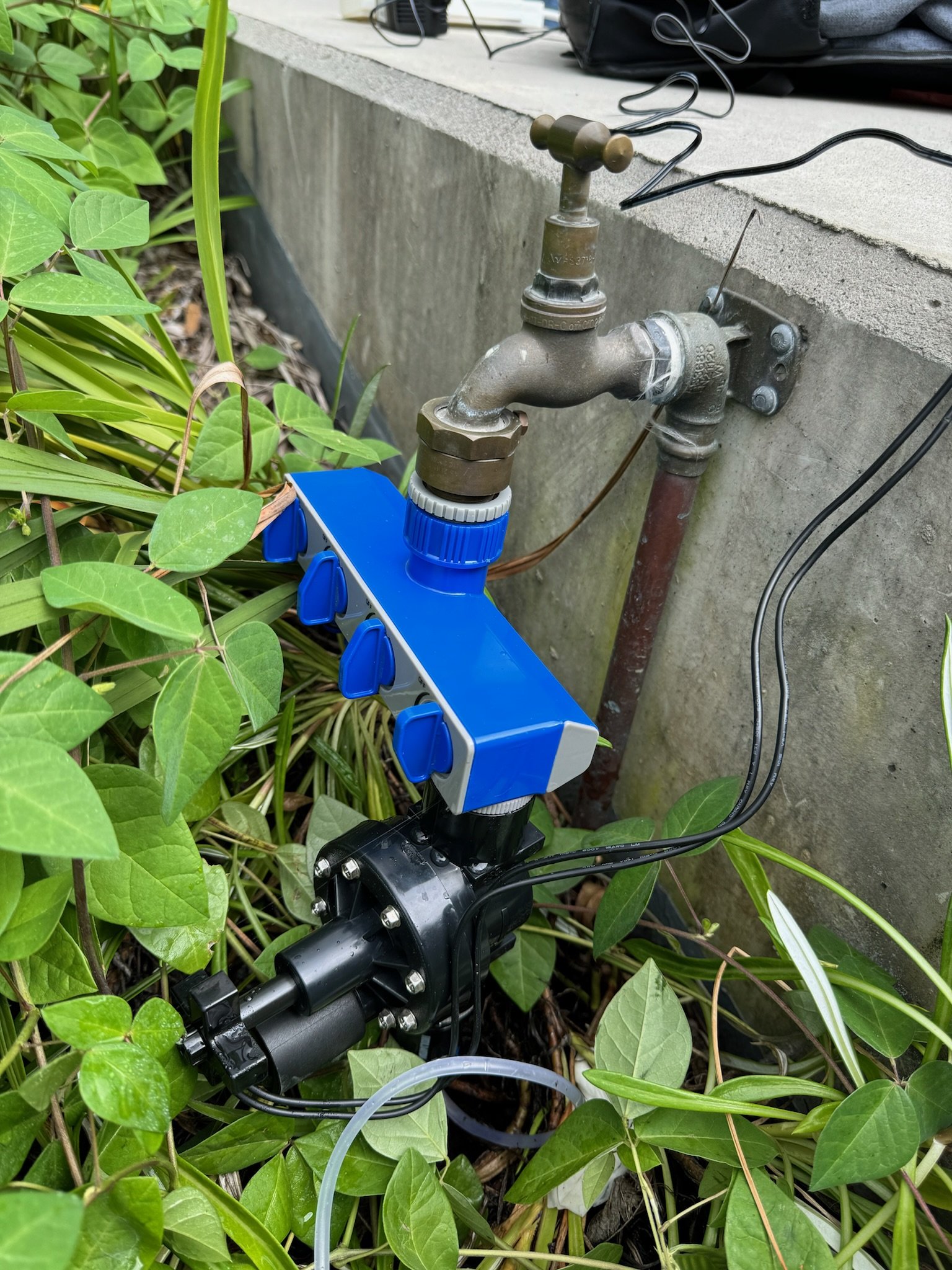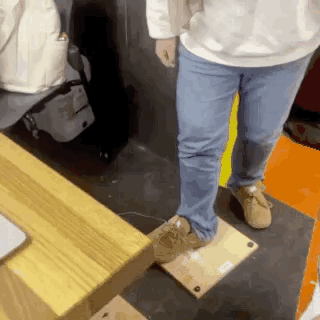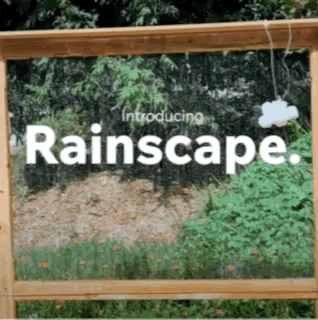RainScape
A playful, immersive room which replicates a natural environment in the rain. Targeting the senses of touch, sight, hearing and scent, users can collaborate to manipulate the space through various playful interactions. We hypothesise this will assist in releasing and reducing stress.
Problem
Research indicates that including small amounts of nature, like plants and natural sounds, can mask noisy industrial sounds in our surroundings and contribute to lowering stress levels. Brief visits to city parks can also reduce stress. However, urban areas with tall buildings and traffic noise make it difficult to establish green spaces.
Studies suggest that an indoor solution using a mix of greenery and sound may offer a better calming effect by engaging multiple senses: hearing, sight, touch, and smell.
Specification
Year: 2024
Duration: 13 Weeks
Team: 5 interaction designers
Role: product designer, researcher
Context: This project is part of Master of Interaction Design course: Physical Computing Studio.
Tools
Arduino, Unity, Solenoid Valves, LED Strip, Pressure sensors
My Role
As this is part of the interaction design team project, I have the main role and the sub-role:
My main role is as the programmer of the code and electrical circuits to control rain, lightning, and thunder by using Arduino and Unity.
My sub-roles are (1) as a researcher using peer-reviewer papers and doing user testing; and (2) designing the interaction between smart objects: clouds, grass floor, and ceiling.
Preview
Poster



Introduction
Context
The course theme is “Future Everyday”, which challenges the teams to create a novel way to interact with technology beyond traditional modes like touchscreen, mouse, or keyboard—presenting the future user experience design.
Source: https://ixd-exhibit.uqcloud.net/
Physical computing diagram, image by Wikipedia.
Key Findings
01
Creating small indoor greenery could help in bringing a similar effect as an outdoor green space, like a park, on happiness and general wellbeing, such as adding plants or an indoor grassy area (Reis et al., 2020).
02
Listening to nature for a short time can reduce stress, including sounds like birds and rustling leaves. Research shows that water sounds can cover up industrial noise too. These findings indicate that a mix of plants, bird sounds, leaf rustling, and water sounds can help ease stress (Tyrväinen et al., 2014; Zhang et al., 2023; Cai et al., 2019)
03
Homma and Akai (2010) suggest that inhaling aromatherapy while taking slow, deep breaths may help reduce anxiety. A study (Schneider, 2016) demonstrated this by showing that using an aromatherapy inhaler led to a drop in cortisol levels after participants breathed in specific essential oil scents. This highlights the potential of adding aromatherapy to stress management strategies.
Objective
The goal is to connect technology with nature, enabling users to playfully explore their impact on the environment. Users experience a multisensory journey with controlling raindrops, lightning intensity, sounds of rain and thunder, and the fresh scent of rain.
The project aims to have an effect on stress relief and relaxation 🧘♀️
Designed for small groups, it offers individual and collective experiences. As users interact with the artefacts, they actively shape the atmosphere, making weather manipulation an expressive act.
Process
User Persona
City BEES
Busy urban workers, typically aged late 20s to mid-40s, often experience overwhelming stress from their fast-paced lifestyles, characterized by demanding jobs and long commutes. This leads to a longing for a break from the chaos of city life, as they seek deeper connections with nature for tranquility and rejuvenation. Weekend getaways to parks, forests, or mountains become essential for them to disconnect from technology and prioritize their mental well-being.
Key Use Cases
Controlling the rainfall
By squeezing the smart cloud stress balls
Our project uses water from a source and controls its flow with solenoid valves managed by Arduino and Unity. A pressure sensor detects user pressure, sending data to Unity to adjust the solenoid valves. This creates different rainfall effects—like a light squeeze for drizzle and a hard squeeze for a heavy shower.
I developed the basic Arduino script and C# code to read the pressure sensor data and handle it in Unity. This code is also adapted for different floor setups and circuit configurations.
Controlling the lightning
By stomping the smart grass floor
A pressure sensor installed underneath a wooden floor will read the input pressure and send it to Unity, where the logic will take place. Unity will control the lightning intensity, making the harder user stomp, the brighter and wider the lightning will be.
Controlling the thunder sounds
By stomping the smart grass floor
Still in the same code as the lightning, as it also got the input from the wooden floor. The difference is that Unity will control the sound intensity of the thunder.
We are using three different thunder sounds where each represent small, medium, and loud thunder—making the experience more authentic.
Design
Storyboard, Interaction scenario

Prototype







Smart object: Cloud stress ball
After user testing, we found our original sewn prototype was too large, and the sensor moved around too much and got lost amongst the cotton.
Our final prototype included a smaller cloud that was easier for users to grip and encased the sensor in sponge to improve the surface area. The pressure sensor is powered by an Arduino system connected to Unity, which allows us to collect pressure readings and control the rainfall intensity and thunder audio. In addition, we replicated the system and combined them to make the experience collaborative for numerous users.
Smart object: grass floor
To create the thunder and lightning we used a similar technology as before utilising sensors, an Arduino board, an LED light strip and Unity. When a user steps on the floor tile, this triggers thunder (Unity sound recording) and lightning (LED strip flashing). Depending on the intensity of the step, the thunder and lightning varies in volume and intensity.
User Testing
Method
Open-ended exploration, questionnaire
Participants
Exploration: 30-40 guests; questionnaire: 8
What’s Good
RainScape was well-received by exhibition visitors, eliciting positive emotions such as delight, surprise, and relaxation as they interacted with the objects.
All participants in the survey reported that RainScape helped them release and reduce stress, and they would like to experience it again.
RainScape's success was further highlighted by 29 vote coins, demonstrating its popularity and positive reception among exhibition attendees.
Concerns
Not all visiting guests were willing to fill out our questionnaire, making the quantitative data less reliable and potentially skewed. This may lead to limitations in understanding overall guest satisfaction and identifying areas for improvement.
There were some delays between input and the output produced by Arduino and unity due to unknown-yet-possibly electrical transmission issues, making some guests’ interactions less than ideal.
Final Design
Controlling the rain
By squeezing the cloud ball to relieve your stress, the rain will fall in front of you with a calming sound, whose intensity depends on how hard you squeeze.
Controlling the lightning and thunder
By stomping the grass floor to release the frustration, thunder and lighting will go off—the harder you stomp, the louder and brighter they will be.
Relaxing to the Aromatherapy and nature sounds.
To improve the experience of immersion for users, we also have included a USB-powered diffuser plugged into our laptop, which disperses the fresh scent of rain throughout the space. Together, these features complement our existing interactions and target the user’s visual and olfactory senses to improve the immersion.
Key takeaways
Personally, this is my favorite course. Not only am I able to build my first physical computing project, I also had a chance to explore Arduino and Unity and how they can empower our future user experience design.
The biggest challenge was the amount of effort put into this since our project is creating a room, which requires many items that are not cheap. The other is avoiding accidental electrocution (which, Thank God, didn’t occur) because the consequence could be fatal.
Anyway, I really enjoyed this project and the Physical Computing course. Many thanks to Dr. Ben Matthews and Dr. Jarrod Knibbe for this awesome experience!
References
Cai, J., Liu, J., Yu, N., & Liu, B. (2019). Effect of water sound masking on perception of the industrial noise. Applied Acoustics, 150, 307-312. https://doi.org/https://doi.org/10.1016/j.apacoust.2019.02.025
Guo, Y., Jiang, X., Zhang, L., Zhang, H., & Jiang, Z. (2022). Effects of Sound Source Landscape in Urban Forest Park on Alleviating Mental Stress of Visitors: Evidence from Huolu Mountain Forest Park, Guangzhou. Sustainability, 14(22), 15125. https://doi.org/10.3390/su142215125
Homma, I., & Akai, L. (2010). Breathing and emotion. Psychology of Happiness, 179.
Reis, S. N., Reis, M. V. D., & Nascimento, Â. M. P. D. (2020). Pandemic, social isolation and the importance of people-plant interaction. Ornamental Horticulture, 26(3), 399-412. https://doi.org/10.1590/2447-536x.v26i3.2185
Schneider, R. (2016). There Is Something in the Air: Testing the Efficacy of a new Olfactory Stress Relief Method (AromaStick®). Stress and Health, 32(4), 411-426. https://doi.org/10.1002/smi.2636
Tyrväinen, L., Ojala, A., Korpela, K., Lanki, T., Tsunetsugu, Y., & Kagawa, T. (2014). The influence of urban green environments on stress relief measures: A field experiment. Journal of Environmental Psychology, 38, 1-9.
Zhang, J., Yan, H., & Wang, D. (2023). Effects of Acoustic Environment Types on Stress Relief in Urban Parks. International Journal of Environmental Research and Public Health, 20(2), 1082. https://doi.org/10.3390/ijerph20021082



















